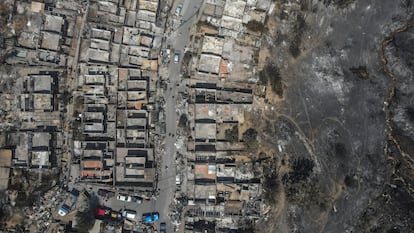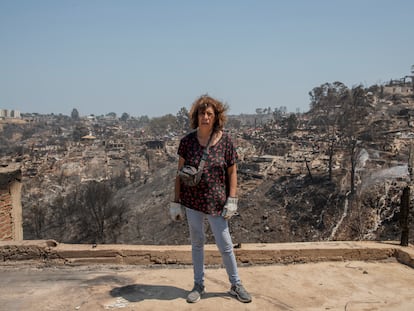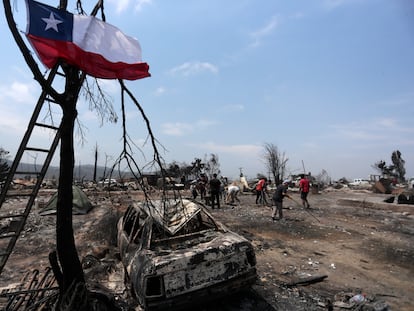Why the fires in Chile destroyed so many lives
The worst tragedy in the South American country since the 2010 earthquake has left at least 131 dead


One of the big questions surrounding the tragedy of the forest fires in Chile is why so many people died. The Legal Medical Service (SML), the state agency in charge of identifying the victims, has reported that the number is 131, but with hundreds missing, authorities have reiterated that the final figure will likely be much higher. The largest fire on record in the South American country was in 2017, when the flames destroyed some 570,000 hectares and left 11 people dead, according to the National Forestry Corporation (Conaf). This year, just over 55,000 hectares have burned.
Investigations to understand how the recent blazes became Chile’s biggest tragedy since the 2010 earthquake are ongoing. So far, experts are offering several reasons:
The role of alerts
In emergency cases, Chileans receive an alert on their phones from the Emergency Alert System (SAE), administered by the National Disaster Prevention and Response Service (Senapred), a government agency. The alert is built into all mobile phones and provides evacuation notices in cases of tsunamis or forest fires. President Gabriel Boric has said that the alerts were sent out, but that “for different reasons the fire was going very fast, at more than 10 kilometers per hour. That’s faster than people walk. But we want to make sure the SAE systems worked and if not, know what happened.” To clear up any doubts, the president commissioned an external investigation from the European Union and collected information gathered through a satellite emergency monitoring program.

Possible arson
Álvaro Hormazabal, director of Senapred, said that planning was based on studies on the number of events that are likely to occur. “When you are faced with about nine fires simultaneously, undoubtedly that does not fit in... There is no system in the world that is prepared for a logic that indicates that there are going to be people lighting fires surrounding a city,” he said, reinforcing the theory about the fires having been set intentionally, a claim that has not been proven until now.
Increase in fires
Fires in Chile are increasing both in frequency and intensity. Those of 2017, also in the central area of the country, forced authorities to modify the scale with which they were being measured globally. “And yet, they continue to be handled as if they were an unexpected surprise,” as Andrea Bizberg, advisor for Latin America on air quality and climate change at C40 Cities, pointed out in a newspaper column recently. According to her research on Global Forest Watch, a digital tool that monitors the state of forests globally, the main trigger of deforestation in Chile is forest plantations, especially in the central area of the country. “The environmental and social impacts of the forestry industry are well documented. And these are exacerbated by climate change,” she noted. Chile is expected to suffer an increase in temperatures combined with water stress. Estimates indicate that average rainfall is 20% less than in past years. This is particularly accentuated in the central area of the country.

Personal reasons
The Minister of the Interior, Carolina Tohá, said: “We have many elements from places where we know that the alert came through and still there were fatalities, either because people delayed evacuating or because they did not notice the fire.” On-the-ground reporting by this newspaper in Viña del Mar evidenced several reasons why some residents died. Older adults, for example, had difficulty moving quickly, cars caused bottlenecks on the narrow roads in the hills, some people received the alert just a few minutes before the fire caught up with them, and others returned to rescue their pets. There have also been complaints from survivors that the alerts did not specify where they should evacuate to.
Sign up for our weekly newsletter to get more English-language news coverage from EL PAÍS USA Edition
Tu suscripción se está usando en otro dispositivo
¿Quieres añadir otro usuario a tu suscripción?
Si continúas leyendo en este dispositivo, no se podrá leer en el otro.
FlechaTu suscripción se está usando en otro dispositivo y solo puedes acceder a EL PAÍS desde un dispositivo a la vez.
Si quieres compartir tu cuenta, cambia tu suscripción a la modalidad Premium, así podrás añadir otro usuario. Cada uno accederá con su propia cuenta de email, lo que os permitirá personalizar vuestra experiencia en EL PAÍS.
¿Tienes una suscripción de empresa? Accede aquí para contratar más cuentas.
En el caso de no saber quién está usando tu cuenta, te recomendamos cambiar tu contraseña aquí.
Si decides continuar compartiendo tu cuenta, este mensaje se mostrará en tu dispositivo y en el de la otra persona que está usando tu cuenta de forma indefinida, afectando a tu experiencia de lectura. Puedes consultar aquí los términos y condiciones de la suscripción digital.










































